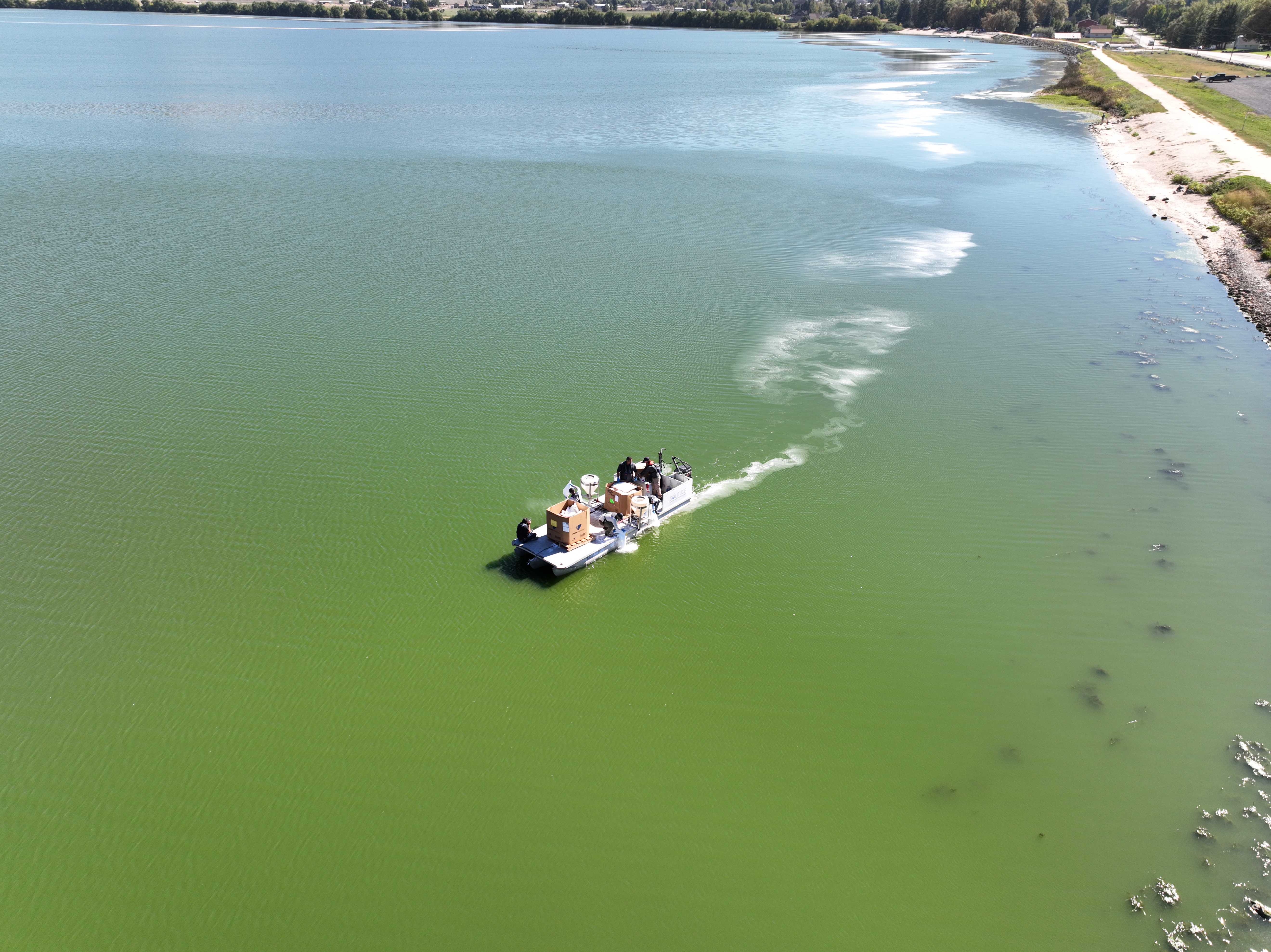Environment
Inside the Herculean Effort to Study and Save the World's Smallest Sea Turtle
After years of steady gains, a decades-long conservation program dedicated to the Kemp's ridley hits rough seas
What Happens to a Tree That Dies in a Forest?
Rotting logs turn out to be vital to forest biodiversity and recycling organic matter
The U.S. Fish and Wildlife Service Wants You to Eat These Giant, Invasive Rodents
As part of National Invasive Species Week, the agency is calling on Americans to “eat the invaders,” including swamp-dwelling nutria
How a Fragile Insect Living 100 Million Years Ago Becomes a Fossil
A bug, a dinosaur and a tree intersect, creating the perfect conditions for resin to capture a moment in time
A Brief and Amazing History of Our Search for Life in the Clouds
By collecting samples after climbing a high peak and firing rockets with special traps into the upper atmosphere, scientists have found microbes living in thin air
Will the Traditional Chinese Medicine Industry End the Pangolin?
The creature is being trafficked across Africa and Asia to fuel a steady demand for their scales, an ingredient in unproven remedies
Can a Small Town’s Protections for Albino Squirrels Inspire Other Cities to Guard Wildlife Against Cats?
Olney, Illinois, has taken steps to protect an iconic mammal from domesticated felines, setting a possible model for other places to follow
The Search to Find the Remains of Homo Erectus in a Vanishing Landscape
A paleontologist journeys through Indonesia’s Riau Archipelago in search of our earliest ancestors, and uncovers how environmental devastation has erased much of the region’s history
Here’s How the Los Angeles Wildfires Are Affecting Animals, From Fish to Snakes to Birds
While scientists were able to save and move some creatures in the aftermath, researchers are worried about the prospects for other species
The Human Brain May Contain as Much as a Spoon's Worth of Microplastics, New Research Suggests
The amount of microplastics in the human brain appears to be increasing over time: Concentrations rose by roughly 50 percent between 2016 and 2024, according to a new study
How Do Polar Bears Keep Ice Off Their Fur? New Study Reveals the Secret—and It Could Improve Technology
The de-icing properties of polar bear sebum could fuel new innovations, scientists say, potentially unlocking alternatives to harmful “forever chemicals” used in ice-resistant coatings today
How A.I. Can Help Humans Battle Wildfires, From Advanced Camera Systems to Forecasting Models
A variety of new technologies aim to improve wildfire detection and help map the spread of blazes
Six Clever Snakes to Celebrate as We Slither Into the Lunar New Year
These fascinating serpents embody acclaimed qualities including cunning and intelligence
How Cleaning Up Harmful Algal Blooms Could Help Fight Climate Change
A company called BlueGreen Water Technologies aims to remove carbon dioxide from the atmosphere while also fighting algae’s toxic effects on people and the environment
Homo Erectus Thrived in a Desert, Study Finds, Suggesting the Early Humans Could Adapt to Extreme Environments
New research suggests modern humans aren't the only hominin species capable of "ecological flexibility"
How Scientists and Composers Teamed Up to Create a Stunning Natural Version of Colombia’s National Anthem
A team trekked for two weeks and collected the sounds of birds, frogs, a jaguar and whales in order to make the song
Melting Ice Reveals Remains of 5,900-Year-Old Trees in Wyoming, Uncovering a Long-Lost Forest
Researchers discovered more than 30 dead whitebark pine trees that were entombed in ice for millennia, representing a bygone ecosystem that could teach us about climate change
Four Lynx Have Been Illegally Released Into the Scottish Highlands. Officials Think ‘Guerrilla Rewilding’ Is to Blame
So far, only two of the four lynx have been recaptured, leaving authorities scrambling across the snowy woods to find the missing cats
Meet the Tiny, Adorable Owls That Have Mastered the Art of Hiding
One of the smallest owls in North America, the northern saw-whet lives among us and is rarely seen—but one volunteer science project aims to find them and uncover their secrets year after year
On This Day in 1951, Four Illuminated Lightbulbs in Idaho Were Evidence of the First Time a Nuclear Power Plant Generated Electricity
Although it was just a byproduct of developing a new type of reactor, the generation of electricity from nuclear energy signaled a bright future ahead
Page 1 of 43
:focal(1200x800:1201x801)/https://tf-cmsv2-smithsonianmag-media.s3.amazonaws.com/filer_public/52/c4/52c44482-cb5b-4b9a-9073-5c8d31f88ded/00_main_img_8685.jpg)
:focal(400x301:401x302)/https://tf-cmsv2-smithsonianmag-media.s3.amazonaws.com/filer_public/7f/de/7fde6df6-8e3e-4a84-8f13-760b079159b6/p-deadwood-in-forest_web.jpg)
:focal(600x480:601x481)/https://tf-cmsv2-smithsonianmag-media.s3.amazonaws.com/filer_public/53/dc/53dc3c53-db29-4855-bbf0-fd88048a4945/nutria_credit_tambako_the_jaguar_cc_by-nd_20_croppedjpg.webp)
:focal(800x602:801x603)/https://tf-cmsv2-smithsonianmag-media.s3.amazonaws.com/filer_public/1b/f4/1bf44de2-9c64-4d5d-9b5c-750080f07fe2/korybingmosquito_web.jpg)
:focal(800x602:801x603)/https://tf-cmsv2-smithsonianmag-media.s3.amazonaws.com/filer_public/3f/99/3f997c82-ebaa-490e-ab84-1b1a90a5d649/gettyimages-1062584288_web.jpg)
:focal(800x602:801x603)/https://tf-cmsv2-smithsonianmag-media.s3.amazonaws.com/filer_public/80/ab/80ab6a8b-2fda-41b5-8028-f0ae913c97d0/main_gettyimages-1228676644_web.jpg)
:focal(800x602:801x603)/https://tf-cmsv2-smithsonianmag-media.s3.amazonaws.com/filer_public/ee/40/ee408048-5a45-4b17-adb5-f26efd16497f/white-squirrels_2_web.jpg)
:focal(800x602:801x603)/https://tf-cmsv2-smithsonianmag-media.s3.amazonaws.com/filer_public/77/c1/77c16160-37f6-4507-a3d0-8df2aea0810d/gettyimages-599177838_web.jpg)
:focal(800x602:801x603)/https://tf-cmsv2-smithsonianmag-media.s3.amazonaws.com/filer_public/f7/de/f7de9662-4215-46b7-bb9d-23b1b9ea8e6f/main_sm_phrynosoma-2241.jpg)
:focal(1920x1097:1921x1098)/https://tf-cmsv2-smithsonianmag-media.s3.amazonaws.com/filer_public/3a/9d/3a9d4ead-68d3-4254-bbc5-ae88fb9ca70e/microplastics-in-lab.png)
:focal(234x156:235x157)/https://tf-cmsv2-smithsonianmag-media.s3.amazonaws.com/filer_public/98/d4/98d4f795-06b9-4c40-b55b-6c97154c97ea/polar_bear.jpg)
:focal(800x602:801x603)/https://tf-cmsv2-smithsonianmag-media.s3.amazonaws.com/filer_public/07/e3/07e32d94-4246-4fb3-84e8-e2f49532dab2/main_gettyimages-2192412412_web.jpg)
:focal(800x602:801x603)/https://tf-cmsv2-smithsonianmag-media.s3.amazonaws.com/filer_public/47/ac/47ac85fc-965e-4bf7-adb0-5fa07c0fcc78/main_rhabdophis_tigrinus_img_6559retouch_web.jpg)

:focal(512x344:513x345)/https://tf-cmsv2-smithsonianmag-media.s3.amazonaws.com/filer_public/69/ca/69ca48a1-c1c8-4e95-838a-7acf5ffcf45c/excavations.jpg)
:focal(800x602:801x603)/https://tf-cmsv2-smithsonianmag-media.s3.amazonaws.com/filer_public/0b/48/0b482fd3-3a4f-47fe-a8db-41c8e7a6f1c9/dsc_1342_web.jpg)
:focal(1050x790:1051x791)/https://tf-cmsv2-smithsonianmag-media.s3.amazonaws.com/filer_public/99/a0/99a0a9a3-6197-404e-a955-e1cae85a9958/img_1940.jpeg)
:focal(1900x1140:1901x1141)/https://tf-cmsv2-smithsonianmag-media.s3.amazonaws.com/filer_public/0e/a3/0ea32f79-42d4-4edc-8bd1-9c64ea5ce8b9/lynx4.jpeg)
:focal(2000x1952:2001x1953)/https://tf-cmsv2-smithsonianmag-media.s3.amazonaws.com/filer_public/3e/70/3e70dcab-8d5a-426a-8184-83c475b0af90/gettyimages-813140808.jpg)
:focal(1024x780:1025x781)/https://tf-cmsv2-smithsonianmag-media.s3.amazonaws.com/filer_public/b5/e5/b5e58418-861a-4853-9370-75e361fc475e/8167845201_6e286f18db_k.jpg)